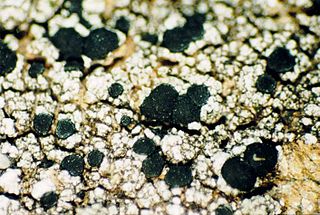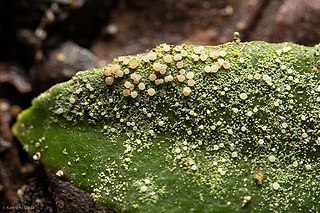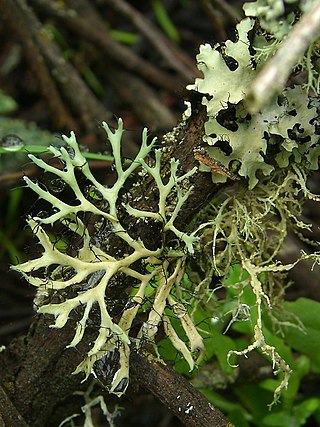
The Lecanoraceae are a family of lichenized fungi in the order Lecanorales. Species of this family have a widespread distribution.

Fellhanera is a genus of mostly leaf-dwelling lichens in the family Pilocarpaceae. The genus, circumscribed by lichenologist Antonín Vězda in 1986, honours Austrian lichenologist Josef Hafellner.
Septotrapelia is a genus of lichen-forming fungi in the family Pilocarpaceae. It has four species. It was validly published as a genus in 2007 by lichenologists André Aptroot and Jose-Luis Chaves.

Bulbothrix is a genus of lichen-forming fungi in the family Parmeliaceae. This genus is synonymous with Bulbothricella V.Marcano, S.Mohali & A.Morales. Bulbothrix was circumscribed by lichenologist Mason E. Hale in 1974 with Bulbothrix semilunata as the type species.

Pyrrhospora is a genus of lichen-forming fungi in the family Lecanoraceae. The genus was circumscribed by German lichenologist Gustav Wilhelm Körber in 1855, with Pyrrhospora quernea assigned as the type species.
Traponora is a genus of lichen-forming fungi in the family Lecanoraceae. The genus was circumscribed in 2009 by Dutch lichenologist André Aptroot, with the Papua New Guinean Traponora asterella assigned as the type, and at that time, only species. Four newly described species were added to the genus in a 2009 publication, a species formerly in Pyrrhospora was transferred to the genus in 2017, and a new species from Australia added in 2018. Traponora lichens are predominantly from Australasia, with all species but one known to occur in Papua New Guinea.

Chrysothrix is a genus of lichen-forming fungi in the family Chrysothricaceae. They are commonly called gold dust lichens or sulfur dust lichens, because they are bright yellow to greenish-yellow, sometimes flecked with orange, and composed entirely of powdery soredia. Apothecia are never present in North American specimens.

Lecanora strobilina, also known as the mealy rim lichen, is a species of crustose lichen in the family Lecanoraceae. It was originally described as Parmelia strobilina by German botanist Kurt Polycarp Joachim Sprengel in 1827. It is distributed across North America and the Mediterranean but has become established in South America and the Galapagos. It can be distinguished from other closely-related species in the genus by the presence of the polyphenolic compound decarboxysquamatic acid in thin-layer chromatography (TLC).

Palicella is a genus of crustose lichens in the family Lecanoraceae. It contains six species.

Polyblastidium is a genus of foliose lichens in the family Physciaceae. It has 18 species. The genus was circumscribed by German lichenologist Klaus Kalb in 2015, with Polyblastidium japonicum assigned as the type species. Polyblastidium is similar in morphology to Heterodermia, but its lower surface is cobweb-like in structure (arachnoid), and its ascospores are mostly 1-septate with 1 to 3 sporoblastidia. It is this latter feature that is referenced in the genus name Polyblastidium. The genus contains several species that were formerly classified in the genus Anaptychia.

Leucodermia is a genus of lichen-forming fungi in the family Physciaceae.

Loxospora is a genus of lichen-forming fungi in the family Sarrameanaceae. It has 13 species. The genus was circumscribed by Italian lichenologist Abramo Bartolommeo Massalongo in 1852, with Loxospora elatina assigned as the type species. This crustose lichen was originally named Lecanora elatina by Erik Acharius in 1810.
Klaus Kalb is a German lichenologist and an authority on tropical lichens.
Lecanora kalbii is a species of crustose lichen in the family Lecanoraceae. Found in the Galápagos Islands, it was described as a new species in 2020 by lichenologists Frank Bungartz and John Alan Elix. The specific epithet kalbii honours German lichenologist Klaus Kalb.

Herpothallon is a genus of crustose lichens in the family Arthoniaceae. It has about 50 species.
Myriostigma is a genus of lichens in the family Arthoniaceae. The genus was circumscribed by German lichenologist August von Krempelhuber in 1874.
Henricus (Harrie) Johannes Maria Sipman is a Dutch lichenologist. He specialises in tropical and subtropical lichens, and has authored or co-authored more than 250 scientific publications. He was the curator of the lichen herbarium at the Berlin Botanical Garden and Botanical Museum from 1983 until his retirement in 2010.

Robert Lücking is a German lichenologist. He earned his master's and PhD from the University of Ulm, focusing on the taxonomy, ecology, and biodiversity of foliicolous lichens. He has received numerous awards for his work, including the Mason E. Hale Award for his doctoral thesis, the Augustin Pyramus de Candolle prize for his monograph, and the Tuckerman Award twice for his publications in The Bryologist. Since 2015, he has been serving as the curator of lichens, fungi, and bryophytes at the Berlin Botanical Garden and Botanical Museum, and several lichen species and a genus have been named in his honour.












